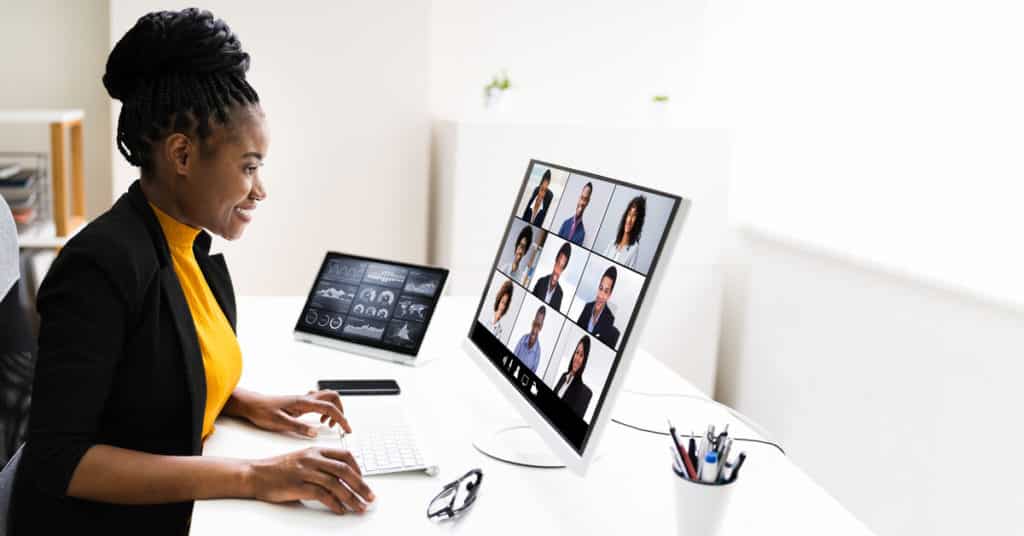The look of your virtual meeting background should depend upon your audience and what image you wish to project. Here's how yours should look.
COVID-19 changed the working world as we knew it, and virtual meetings have now become an integral part of everyday life. In fact, it’s probably odd if a weekday goes by where you aren’t on a virtual meeting.
Suffice to say, you’ve probably seen it all on virtual meetings. Dogs barking, kids running around with superhero capes, and people showing up to meetings in their pajamas. However, even with remote jobs, it’s possible to keep a professional image, and one of best things you can do is utilize a virtual background.
What are Virtual Backgrounds?
Virtual backgrounds are simulated environments that appear behind you on your screen. They can be a beach, corner office overlooking a skyscraper, a fancy kitchen, or even the aquarium! Zoom has many virtual background options and they’ve become extremely popular for meetings.
Efficiently track and document board decisions with our Meeting Minutes Template
Why Use Virtual Backgrounds?
Virtual backgrounds keep your meetings professional. You might be walking on the treadmill or sitting in an Uber when taking your meetings, but the other participants will never know if you use a virtual background. They can also be great conversation-starters, minimize distractions, and give your meetings a new energy.
How to Keep Your Virtual Background Professional
Everyone has seen the Zoom background that doesn’t quite fit the meeting or is really distracting (are you really taking this call from the moon?!) It can throw off the meeting and even hurt your personal brand. If you’re looking to keep your virtual backgrounds professional, here are 6 tips.
1. Choose a relevant background for your meeting audience
Different backgrounds are appropriate for different types of meetings, and it’s important to understand your audience and the goal of the meeting. While a graphic of a beautiful white sand beach might be serene, it might not be appropriate for a monthly board meeting. Try to pick a theme that reflects the setting. For a board meeting, that might be an office building, corporate boardroom, or even a solid background.
2. Select appropriate background colors
A study found that light greys and neutral colors are the best colors to use when you’re interviewing, and you should steer clear of reds. Colors have psychological effects on people. Red evokes emotions of passion and anger, while grey represents neutrality and balance. Blue represents calmness and serenity, so that can also be an appropriate color, depending on the type of feeling you want to emit during the meeting.
3. Avoid distracting patterns
While an interesting pattern may look good as your kitchen backsplash, it can be distracting for a professional meeting. You have an important agenda for your meeting and the last thing you want is someone to be so distracted by your background, that they can’t concentrate on what you’re saying. Avoid repeating patterns, especially with a lot of color.
4. Purchase a Green Screen
A green screen is “a visual effects (VFX) technique where two images or video streams are layered—i.e. composited—together. Green screen basically lets you drop in whatever background images you want behind the actors and/or foreground. It’s used in film production (and also in news and weather reports) to relatively simply place the desired background behind the subject/actor/presenter.”
Using a green screen allows you to be transposed into the virtual background smoothly. Without it, you may see lines or blotches of color on your screen, which can be distracting and look unprofessional.
5. Use proper lighting
Have you ever been on a Zoom call where the person you’re speaking to looks like they’re in the witness protection program? It doesn’t matter what type of virtual background you use if no one can see you. Lighting can make you look clearer and more professional, and it doesn’t require a huge monetary investment. If your home office has windows, turn your desk toward the window so the natural light will shine on your face and light up the background. You can also position a lamp or LED ring in front of you to illuminate your face.
6. Choose Immersive View
If you have several participants that you want to fit into one background, you can use Zoom’s immersive view and “recreate the feel of your class or conference room.” The host must select this option and participants are automatically placed onto a single virtual background and scenes when they enter the meeting.
How to Add a Virtual Meeting Background on Zoom
Zoom has a variety of virtual backgrounds you can select. To enable Virtual Background for Zoom Rooms on your account:
- Sign in to the Zoom web portal as an admin.
- In the navigation menu, click Room Management, then Zoom Rooms.
- Click Account Settings.
- Click the Account Profile tab.
- Under Setup, click the Virtual Background with Greenscreen toggle to enable or disable it.
- If a verification dialog displays, click Enable or Disable to verify the change.
- (Optional) To prevent all users in your account from changing this setting, click the lock icon, and then click Lock to confirm the setting.
- Click Upload Background to add more background choices to the default library.
An Add Content pop-up window will appear. - Click Choose Files to choose files to upload from your computer.
You can also drag and drop images or videos in the pop-up window. - Click Add items.
General Appearance Tips for Virtual Meetings
Clothing
While 60% of people report wearing sweatpants on Zoom calls, the best advice has always been to dress for the job you want, even if it’s remote. In fact, according to the theory of enclothed cognition, “people tend to embody the traits that their garments represent.” Not only does dressing up for your board meeting add to your professional essence, it gives you confidence and can help you focus.
Eye contact
Eye contact is important during in-person meetings, but it can be hard to pull off on-camera. The only way to achieve good eye contact on-camera is to look directly into the lens of your camera. This will be awkward at first, because you’re probably used to primarily looking at the screen, but it will get easier with time. You’ll also want to make sure you occasionally look at the screen to gauge reactions and body language of the other participants.
Body language
Your body language can say a lot about your overall attitude, engagement, and personality. Open postures and smiling are generally perceived as positive. Hand gestures can make what you’re saying easier to understand and more approachable.
Manage Professional Virtual Meetings With OnBoard
Your virtual background is only one part of the equation. If you’re hosting a virtual board meeting, you’ll also want to prepare for the meeting by sending out the materials in advance, accomplishing smaller tasks before the meeting, and utilizing a board portal.
Ready to make your board meetings more professional? Request a demo or a free trial of OnBoard, the board intelligence platform that allows seamless collaboration and actionable board intelligence.
The comprehensive blueprint for selecting a results-driven board management vendor.
Want to fuel your startup for success? Get started with a free trial of OnBoard.
About The Author

- Adam Wire
- Adam Wire is a Content Marketing Manager at OnBoard who joined the company in 2021. A Ball State University graduate, Adam worked in various content marketing roles at Angi, USA Football, and Adult & Child Health following a 12-year career in newspapers. His favorite part of the job is problem-solving and helping teammates achieve their goals. He lives in Indianapolis with his wife and two dogs. He’s an avid sports fan and foodie who also enjoys lawn and yard work and running.
Latest entries
 Board Management SoftwareApril 23, 2024How to Form a Crisis Response Team (Step-by-Step)
Board Management SoftwareApril 23, 2024How to Form a Crisis Response Team (Step-by-Step) Board Management SoftwareApril 12, 2024Board of Directors Compliance Training: 5 Best Programs
Board Management SoftwareApril 12, 2024Board of Directors Compliance Training: 5 Best Programs Board Management SoftwareApril 10, 20245 Best Compliance Training Programs
Board Management SoftwareApril 10, 20245 Best Compliance Training Programs Board Management SoftwareMarch 28, 20245 Advantages of an Initial Public Offering
Board Management SoftwareMarch 28, 20245 Advantages of an Initial Public Offering

